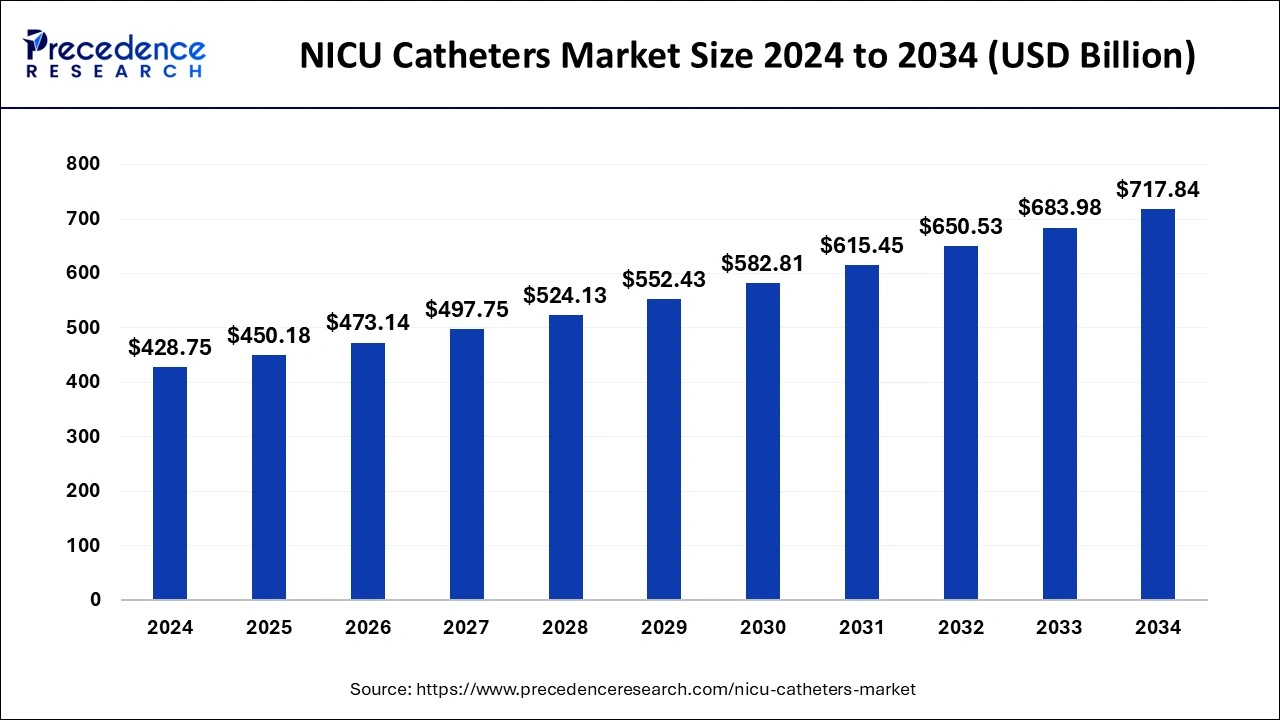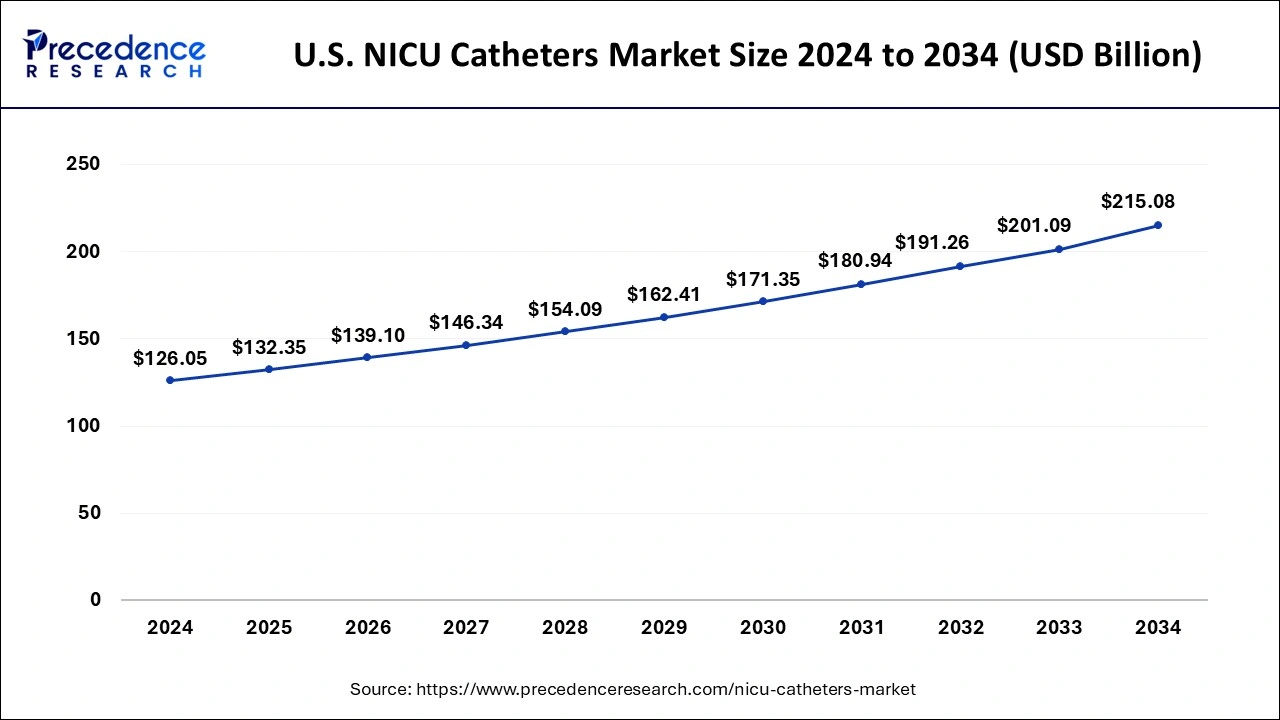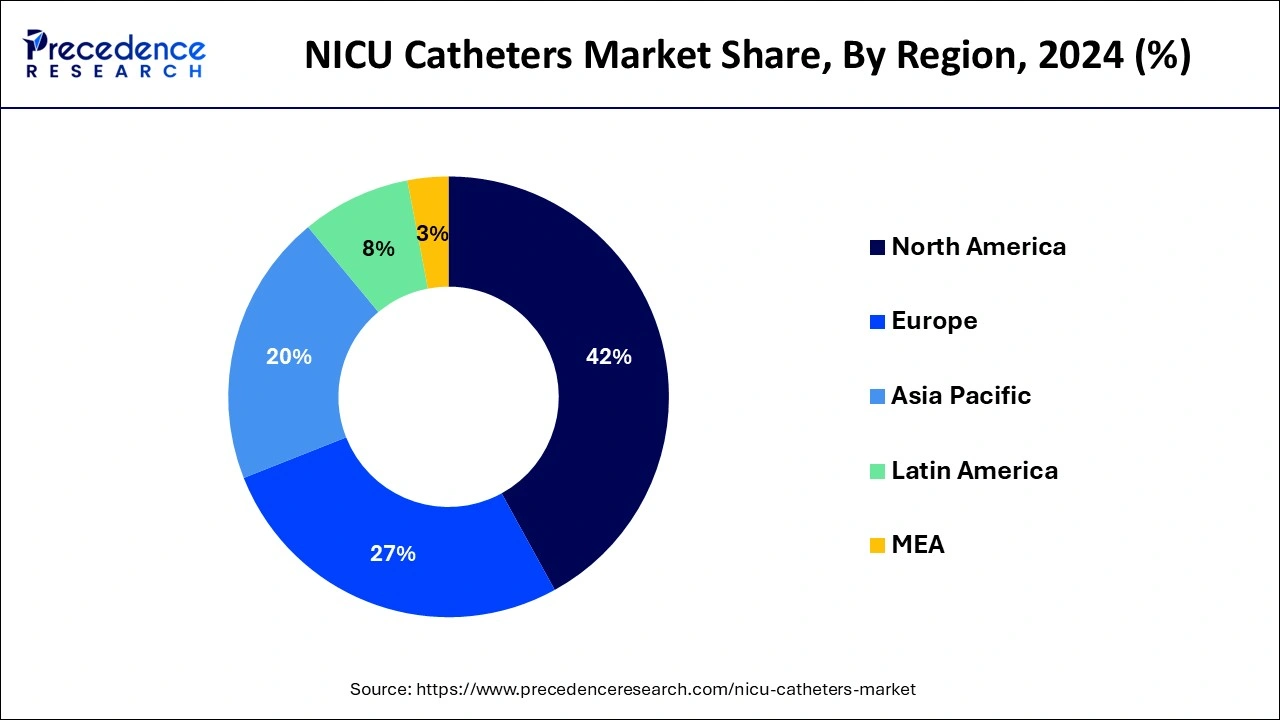January 2025
The global NICU catheters market size is accounted at USD 450.18 billion in 2025 and is forecasted to hit around USD 717.84 billion by 2034, representing a CAGR of 5.29% from 2025 to 2034. The North America market size was estimated at USD 180.08 billion in 2024 and is expanding at a CAGR of 5.41% during the forecast period. The market sizing and forecasts are revenue-based (USD Million/Billion), with 2024 as the base year.
The NICU catheters market size accounted for USD 428.75 billion in 2024 and is expected to exceed around USD 717.84 billion by 2034, growing at a CAGR of 5.29% from 2025 to 2034.

The U.S. NICU catheters market size was exhibited at USD 126.05 billion in 2024 and is projected to be worth around USD 215.08 billion by 2034, growing at a CAGR of 5.49% from 2025 to 2034.

Based on the region, the North America segment dominated the global neonatal intensive care units (NICU) catheters market in 2022, in terms of revenue and is estimated to sustain its dominance during the forecast period. The health care systems in the North America region are well developed and structured. In addition, these platforms promote research and development. This factor is driving the growth of the market in the region.

On the other hand, the Asia-Pacific is estimated to be the most opportunistic segment during the forecast period. As a result of increased awareness, some local and small market players are emerging throughout Asia-Pacific. This has also aided the neonatal intensive care units (NICU) catheters market’s expansion.
The percutaneous indwelling central catheters are placed with the help of central catheters. The chemotherapy, antibiotic therapy, total parenteral nutrition, and the delivery of medications that should not be administered peripherally are all common uses for neonatal intensive care units (NICU) catheters lines. The peripherally inserted central catheters (PICCs) lines are introduced percutaneously into the body at a peripheral location and stretched to the superior vena cava. It’s a substitute for a central venous catheter, which is put into major veins like the femoral and jugular. The patients who have been on treatment for more than two weeks use a peripherally inserted central catheters (PICCs) line. The dwell time, on the other hand, varies from case to case. Holding a neonatal intensive care units (NICU) catheters for longer than a month may result in problems such as hemorrhage, phlebitis, and catheter blockage. To limit the risk of infection, strict infection control protocols should be undertaken prior to the placement of a neonatal intensive care units (NICU) catheters.
The major types of neonatal intensive care units (NICU) catheters are peripherally inserted central catheters (PICCs), umbilical venous catheters (UVCs), and central venous catheters (CVCs). Up to 14 days, a neonate’s exposed umbilical stump is used as a location for emergency central venous access. During resuscitation, umbilical venous catheters (UVCs) can be safe and effective way to give drugs and fluids intravenously. The umbilical vein is a possible point of venous access for a qualified practitioner; however, it is most typically used for resuscitation in the delivery room. While peripheral intravenous access is recommended for administering drugs to neonates, neonatal physicians should be knowledgeable in a variety of IV access procedures, including intraosseous lines, central venous catheters, peripheral IVs, and umbilical vein access. While intraosseous access is a neonate has been shown to be faster than an umbilical vein catheter, the difficulty in placing an intraosseous in a neonate and the risk of dislodgement during a code make umbilical venous catheters (UVCs) an appealing modality for intravenous access by personnel trained in the procedure.
| Report Coverage | Details |
| Market Size in 2025 | USD 450.18 Billion |
| Market Size in 2034 | USD 717.84 Billion |
| Growth Rate from 2025 to 2034 | CAGR of 5.29% |
| Base Year | 2024 |
| Largest Market | North America |
| Fastest Growing Market | Asia Pacific |
| Forecast Period | 2025 to 2034 |
| Segments Covered | Type, End-User, Region |
| Regions Covered | North America, Europe, Asia-Pacific, Latin America, and Middle East & Africa |
The insertion of central venous catheters (CVCs) is a common and often necessary technique in the treatment of critically unwell patients. Depending on the need for catheter placement, different devices can be used to gain central venous access. The catheters are commonly used to administer vasoactive drugs and compounds that are recognized venous irritants, but they can also be used to perform dialysis and plasmapheresis or as a conduit to introduce other devices for more complex operations. This process examines central venous catheters (CVCs) placement and the role of the interprofessional team in the care of patients who have this procedure done.
Many of the global companies seek to enter the neonatal intensive care units (NICU) catheters market with unique and technologically advanced and developed products. These advancements offer plenty of opportunities in the global neonatal intensive care units (NICU) catheters market, allowing for easy use of vascular access devices while also increasing patient safety. The multiple births during pregnancy are linked to low weight of baby, an increased risk of premature birth, and other high-risk conditions. The need for neonatal intensive care units (NICU) catheters services rises as a result of this.
The neonatal intensive care units (NICU) catheters services are in high demand due to the high-risk conditions and circumstances during pregnancy. More than 50% of newborn deaths worldwide are caused by infections. This has resulted in a greater demand for early diagnosis and treatment in hospitals, resulting in a rise in neonatal intensive care units (NICU) admissions. The global market for neonatal intensive care units (NICU) catheters is expected to expand as a result of these factors during the forecast period.
The global neonatal intensive care units (NICU) catheters market is predicted to grow because to the increased adoption of neonatal intensive care units (NICU) lines, which will necessitate the development of safer and improved catheter insertion technologies as well as the availability of qualified professionals. In the long-term management of problems, the cost of the vascular access device and its maintenance is a critical economic concern. This factor is hampering the growth of the neonatal intensive care units (NICU) catheters market.
Based on the type, the peripherally inserted central catheters (PICCs)segment dominated the global neonatal intensive care units (NICU) catheters market in 2022, in terms of revenue and is estimated to sustain its dominance during the forecast period. A central line with a peripherally inserted central catheters (PICCs) is a specific form of central line. An intravenous (IV) line is similar to a central line. However, it is significantly longer than a standard IV and extends all the way to a vein near or inside the heart.
On the other hand, the umbilical venous catheters (UVCs)segment is estimated to be the most opportunistic segment during the forecast period. The umbilical venous catheters (UVCs) are used for blood gas sampling, blood pressure monitoring, exchange transfusions, fluid infusions, central venous pressure monitoring, and emergency vascular access for infusions of blood and fluid products or pharmaceuticals.
The regulatory clearances, acquisitions, product development, collaborations, partnerships with other companies are all areas of focus for key market players in the global neonatal intensive care units (NICU) catheters market. Over the next few years, these initiatives are projected to fuel the expansion of the global neonatal intensive care units (NICU) catheters market.
By Type
By End User
By Geography
For inquiries regarding discounts, bulk purchases, or customization requests, please contact us at sales@precedenceresearch.com
No cookie-cutter, only authentic analysis – take the 1st step to become a Precedence Research client
January 2025
August 2024
March 2025
February 2025